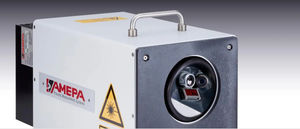

- Products
- Catalogs
- News & Trends
- Exhibitions
Flow detector TSD 2.0slagoxygeninfrared



Add to favorites
Compare this product
Characteristics
- Detected entity
- flow, slag
- Gas type
- oxygen
- Technology
- infrared, thermal, infrared camera, electric
Description
The ever-increasing demands on the degree of steel purity require the slag-free transfer of liquid steel from the oxygen steel converter or electric furnace into the ladle. A prerequisite for this demand is that entrainment of slag into the liquid steel can be detected. AMEPA’s latest slag detection system now detects slag flow into the steel on a thermographic basis.
Thermographic slag detection takes advantage of the fact that the thermal radiation characteristics of steel and slag in the higher infrared range are significantly different at the same temperature.
A thermographic slag detection system essentially comprises one infrared camera, which observes the tapping stream, an evaluation computer, and a display device. The infrared camera is installed in an air-cooled housing to protect it against damage and radiation.
The camera image is displayed in a false-color representation on a monitor at the system and on additional monitors at the tapping stand.
The Benefits
Compared to other methods of slag detection at the converter and electric furnace tapping, this method has the following advantages:
Efficient
Thermographic slag detection with AMEPA TSD 2.0 does not require any sensors or other similar methods to be installed in the vessel. This results in low maintenance costs and servicing costs for the user. In case of necessary system maintenance or repairs, an intervention may be possible during an ongoing process depending on the location of the installation to the pouring stream and dangerous areas.
Reliable
As various algorithms and compensations are integrated into the AMEPA TSD 2.0, these systems are independent
*Prices are pre-tax. They exclude delivery charges and customs duties and do not include additional charges for installation or activation options. Prices are indicative only and may vary by country, with changes to the cost of raw materials and exchange rates.





